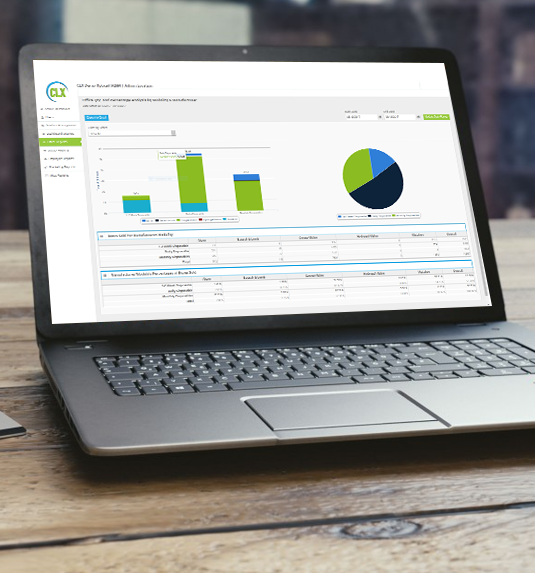Which contact lenses did You Really Fit in 2018?
When it comes to fitting contact lenses in your office, are you taking advantage of the data at your fingertips? More and more eye care professionals are discovering that they can maximize profits and patient compliance by taking a deliberate approach to contact lens fitting (we call this a fitting strategy).
When we surveyed practices about their goals when fitting patients with contact lenses, we heard some common responses: each individual practice has their own approved formulary and strategy for fitting contact lenses, but on a high level, there are many similarities across the industry. For example, the past few years have seen an industry-wide movement toward prioritizing daily disposable lenses.
Here’s the problem: as we move into 2019, most practices do not have full transparency into the contact lenses that they fit. Without specific data, it’s difficult to measure success and find opportunities for improvement. Good news: CLX can help. Keep reading if you want to answer the question: What lenses did you really fit in 2018?
When it comes to fitting contact lenses in your office, are you taking advantage of the data at your fingertips? More and more eye care professionals are discovering that they can maximize profits and patient compliance by taking a deliberate approach to contact lens fitting (we call this a fitting strategy).
When we surveyed practices about their goals when fitting patients with contact lenses, we heard some common responses: each individual practice has their own approved formulary and strategy for fitting contact lenses, but on a high level, there are many similarities across the industry. For example, the past few years have seen an industry-wide movement toward prioritizing daily disposable lenses.
Here’s the problem: as we move into 2019, most practices do not have full transparency into the contact lenses that they fit. Without specific data, it’s difficult to measure success and find opportunities for improvement. Good news: CLX can help. Keep reading if you want to answer the question: What lenses did you really fit in 2018?

The Benefits of Keeping Track of the Contact Lenses You Fit
A major upside to knowing exactly what you fit is to address key components, the clinical aspects of what is best for your patient, and the ability to increase profits and grow your contact lens business. Seeing the real time numbers can tell you whether you’re consistently fitting products that are the best technology for your patients, and also have the best margins for your practice. And conversely… if not, how you can make a concerted effort to improve the lenses fit to match your preferred lens formulary.
Of course, you have to take patient compliance into consideration. As a best practice, we have worked with ECPs to create preferred lens formularies that combine profitability with the products shown to be used in safe, healthy ways by patients. This helps explain the recent trend towards daily disposable lenses that often have a slightly lower profit margin but a higher rate of patient compliance than the alternatives.
Finally, knowing what you fit equates to the ability to measure performance within your practice. By seeing the numbers broken down by staff member, including whether your team is on track by sticking to your formulary and selling more full year supplies. By being able to view who is having the most success, you can use insights from the highest performers to optimize your fitting strategy by incorporating their best practices.

The Benefits of Keeping Track of the Contact Lenses You Fit
A major upside to knowing exactly what you fit is the ability to increase profits and grow your contact lens business. Seeing the numbers can tell you whether you’re consistently fitting products with high margins, and if not, how you can make a concerted effort to improve your margins going forward.
Of course, you have to take patient compliance into consideration. Practices create formularies that combine profitability with the products shown to be used in safe, healthy ways by patients. This helps explain the recent trend towards daily disposable lenses that often have a slightly lower profit margin but a higher rate of patient compliance than the alternatives.
Finally, knowing what you fit equates to the ability to measure performance within your practice. By seeing the numbers broken down by staff member, including whether your team is on track by sticking to your formulary and selling more full year supplies. By being able to view who is having the most success, you can use insights from the highest performers to optimize your fitting strategy by incorporating their best practices.
Get the Most Out of CLX
You can your view contact lens fitting data directly in CLX. Our system automatically generates reports broken down by modality, formulary, and doctor.
As you place your contact lens orders, CLX monitors and automatically prepares the data in an easy-to-use dashboard. Our system also maintains an updated catalog of every contact product on the market, reducing inefficiencies that result from using outdated product and pricing information, making practice administration more productive.
If you’re not already using CLX’s advanced reporting tools to your advantage, it’s time to look back at what you fit in 2018 and use insights to optimize your fitting strategy for the coming year. Getting the numbers on what you’re fitting can give you the opportunity to pursue a cohesive fitting strategy, develop best practices, increase patient compliance, and grow your practice’s total revenue..
At CLX, our goal is to make sure your team leverages the complete system in a way that helps your practice compete and succeed in the contact lens marketplace.
LOOKING TO ADOPT THESE CONTACT LENS BUSINESS TOOLS OR LEARN MORE ABOUT OPTIMIZING THEM FOR YOUR PRACTICE?

